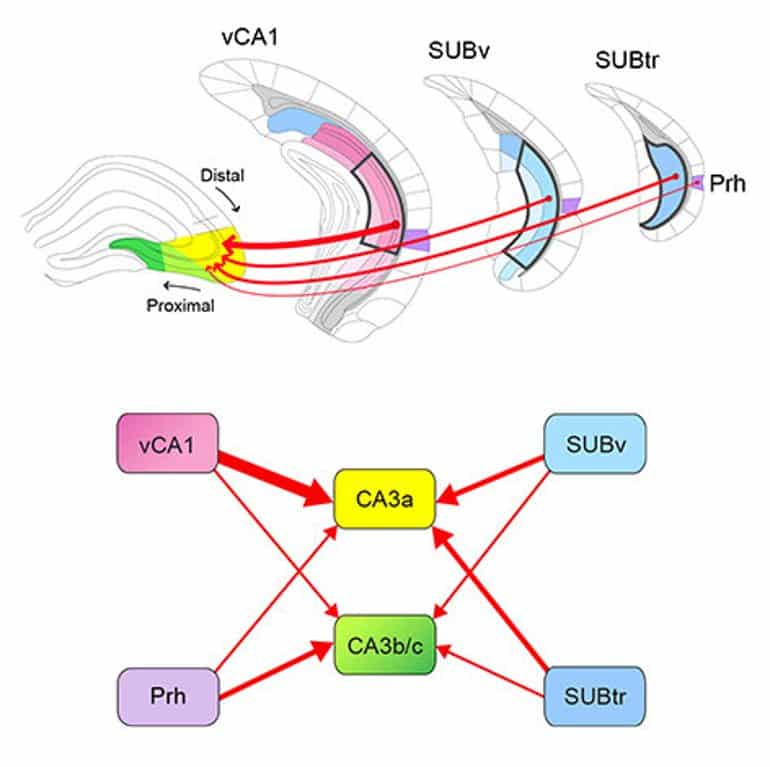Summary: Study identifies a novel neural circuit that regulates spatial learning and memory in the brain’s hippocampal formation.
Source: UC Irvine
A research team led by University of California, Irvine has discovered new neural circuits that regulate spatial learning and memory in the brain’s hippocampal formation.
The team identified novel functional roles of new circuit connections between the venal CA1 region and dorsal CA3 regions of the hippocampus and demonstrated that genetic inactivation of this projection impairs object-related spatial learning and memory, but does not modulate anxiety-related behaviors.
The study, titled “Non-canonical projections to the hippocampal CA3 regulate spatial learning and memory by modulating the feedforward hippocampal trisynaptic pathway,” was published today in PLOS Biology.
The hippocampus is not a homogenous brain area. The septotemporal axis, along which the trisynaptic pathway is located, separates the dorsal region of the hippocampus, which is more involved in learning, memory and spatial navigation, and the ventral region, which plays a role in emotional behavior. The trisynaptic’s feedforward, unidirectional circuit organization is well documented, but the connectivity across septal to temporal regions is less well described.
“Our findings extend the knowledge of hippocampal connectivity and its relation to learning and memory processes across the septotemporal axis and provide a circuit foundation to explore these novel functional roles,” said Xiangmin Xu, Ph.D., Chancellor’s Fellow and professor of anatomy and neurobiology, and director for the Center for Neural Circuit Mapping (CNCM) at the UCI School of Medicine.
“The new hippocampal circuit mechanism is highly relevant to treating learning and memory disorders, including Alzheimer’s disease.”

Building on their earlier work, Xu and his team used multiple viral tracers, including monosynaptic rabies retrograde tracing and herpes (H129)-based anterograde tracing to establish new hippocampal CA1 projections to CA3. Robust mapping results showed that CA1 inputs to CA3 run opposite the trisynaptic pathway and in a temporal to septal direction. They also found that genetic inactivation of the CA1 to CA3 projection impaired object-related spatial learning and memory, but did not modulate anxiety-related behaviors.
“The emergence of viral-genetic mapping techniques enhances our ability to determine the detailed complexity of brain circuity,” Xu said. “Our study was made possible by the new viral genetic tools developed by our CNCM investigators at UCI. We are developing these new viral tracers as brain mapping tools, which we plan to share through our center for use by the neuroscience community.”
About this learning and memory research news
Author: Press Office
Source: UC Irvine
Contact: Press Office – UC Irvine
Image: The image is credited to UC Irvine
Original Research: Open access.
“Noncanonical projections to the hippocampal CA3 regulate spatial learning and memory by modulating the feedforward hippocampal trisynaptic pathway” by Xiaoxiao Lin et al. PLOS Biology
Abstract
Noncanonical projections to the hippocampal CA3 regulate spatial learning and memory by modulating the feedforward hippocampal trisynaptic pathway
The hippocampal formation (HF) is well documented as having a feedforward, unidirectional circuit organization termed the trisynaptic pathway. This circuit organization exists along the septotemporal axis of the HF, but the circuit connectivity across septal to temporal regions is less well described.
The emergence of viral genetic mapping techniques enhances our ability to determine the detailed complexity of HF circuitry. In earlier work, we mapped a subiculum (SUB) back projection to CA1 prompted by the discovery of theta wave back propagation from the SUB to CA1 and CA3. We reason that this circuitry may represent multiple extended noncanonical pathways involving the subicular complex and hippocampal subregions CA1 and CA3. In the present study, multiple retrograde viral tracing approaches produced robust mapping results, which supports this prediction.
We find significant noncanonical synaptic inputs to dorsal hippocampal CA3 from ventral CA1 (vCA1), perirhinal cortex (Prh), and the subicular complex. Thus, CA1 inputs to CA3 run opposite the trisynaptic pathway and in a temporal to septal direction. Our retrograde viral tracing results are confirmed by anterograde-directed viral mapping of projections from input mapped regions to hippocampal dorsal CA3 (dCA3). We find that genetic inactivation of the projection of vCA1 to dCA3 impairs object-related spatial learning and memory but does not modulate anxiety-related behaviors.
Our data provide a circuit foundation to explore novel functional roles contributed by these noncanonical hippocampal circuit connections to hippocampal circuit dynamics and learning and memory behaviors.






